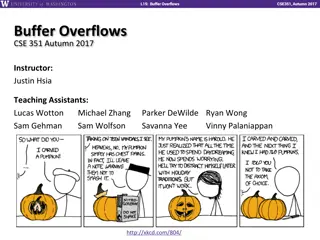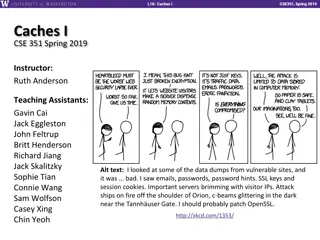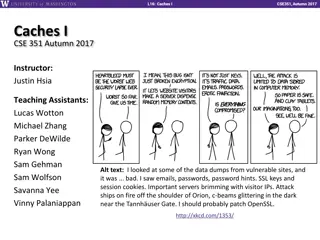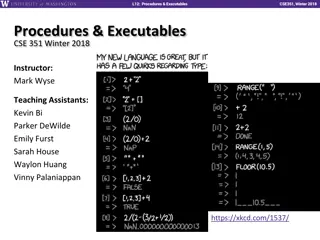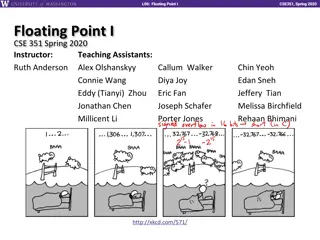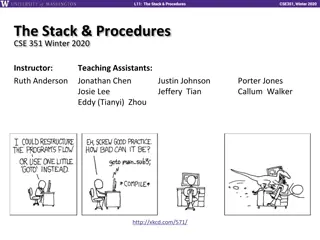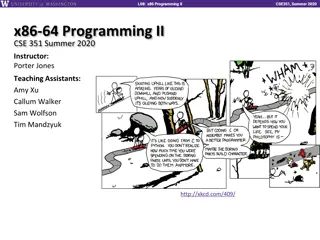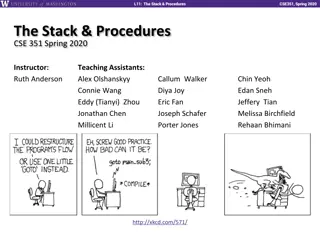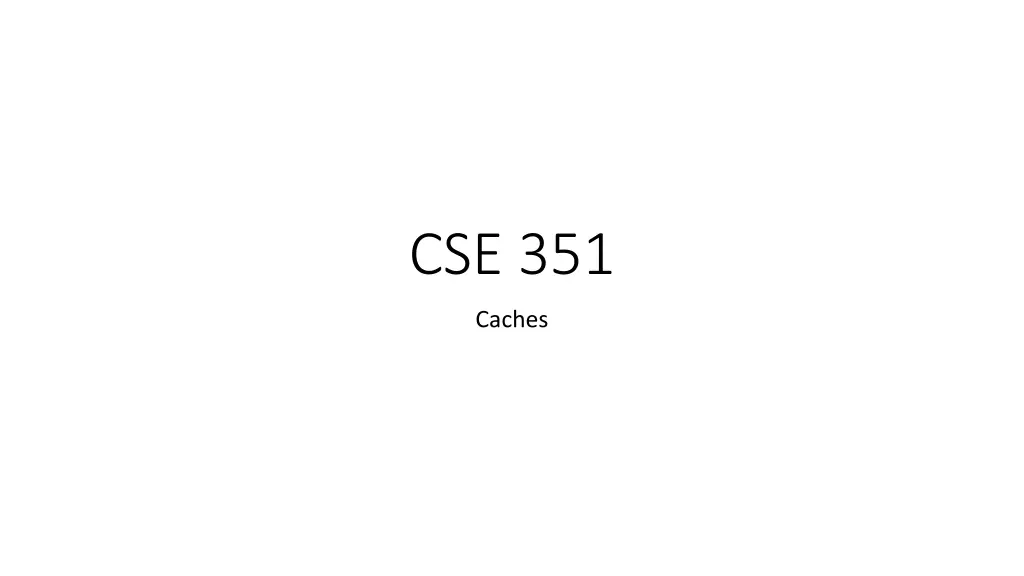
Understanding Cache Memory and Performance Optimization
Learn about the significance of cache memory in optimizing program performance. Explore concepts such as cache associativity, mapping, and the benefits of caching in reducing memory accesses. Dive into examples to grasp direct-mapped cache structures.
Download Presentation

Please find below an Image/Link to download the presentation.
The content on the website is provided AS IS for your information and personal use only. It may not be sold, licensed, or shared on other websites without obtaining consent from the author. If you encounter any issues during the download, it is possible that the publisher has removed the file from their server.
You are allowed to download the files provided on this website for personal or commercial use, subject to the condition that they are used lawfully. All files are the property of their respective owners.
The content on the website is provided AS IS for your information and personal use only. It may not be sold, licensed, or shared on other websites without obtaining consent from the author.
E N D
Presentation Transcript
CSE 351 Caches
Section Feedback Before we begin, we d like to get some feedback about section If you could answer the following questions on the provided notecard that would be great: What is working? What is not working? What should we start doing? This is anonymous! Don t put your name on the notecard
Cache Summary Fast memory that exists between registers and main memory Takes advantage of temporal + spatial locality Temporal locality: Programs often access the same location multiple times Spatial locality: Programs often read/write to adjacent locations Caching can greatly reduce the number of accesses to main memory Programs run much faster this way Caching is taken care of by the hardware Programmers do not have explicit control over the caches
Cache Associativity Determines the number of different locations a given address can map to in the cache Ex. Cache associativity = 1 (direct-mapped) This means that every address has only one possible line it can map to Ex. Cache associativity = Cache size / Block size (fully-associative) This means that any address can map to any line of the cache
Cache Mapping To determine where addresses map into a cache, you need to break the address space up into TAG, SET, and OFFSET bits Work from right to left The log(B)-most bits are used to express block offset The next log(S)-most bits are used to express the set number The remaining bits represent the tag
Cache Mapping Why do we order the bits TAG|INDEX|OFFSET? This allows caches to capitalize on locality OFFSET bits are the lowest-order bits Adjacent addresses are thus in the same block Takes advantage of spatial locality INDEX bits are next Adjacent blocks are in different sets Takes advantage of temporal locality The location of the TAG bits is a result of the placement of the first two sets of bits
Example Cache: direct-mapped Set Valid Tag B0 B1 B2 B3 Set Valid Tag B0 B1 B2 B3 0 1 15 63 B4 C1 A4 8 0 - - - - - 1 0 - - - - - 9 1 00 01 12 23 34 2 0 - - - - - 10 1 01 98 89 CB BC 3 1 0D DE AF BA DE 11 0 1E 4B 33 10 54 4 0 - - - - - 12 0 - - - - - 5 0 - - - - - 13 1 11 C0 04 39 AA 6 1 13 31 14 15 93 14 0 - - - - - 7 0 - - - - - 15 1 0F FF 6F 30 00
Example Cache: 2-way set associative Set Valid Tag B0 B1 B2 B3 Set Valid Tag B0 B1 B2 B3 0 0 - - - - - 0 0 - - - - - 1 0 - - - - - 1 1 2F 01 20 40 03 2 1 03 4F D4 A1 3B 2 1 0E 99 09 87 56 3 0 - - - - - 3 0 - - - - - 4 0 06 11 23 6A 42 4 0 - - - - - 5 1 21 DE AD BE EF 5 0 - - - - - 6 0 - - - - - 6 1 37 22 B6 DB AA 7 1 11 00 12 51 55 7 0 - - - - -
Example Cache: fully-associative Set Valid Tag B0 B1 B2 B3 Set Valid Tag B0 B1 B2 B3 0 1 1F4 00 01 02 03 0 0 - - - - - 0 0 - - - - - 0 1 AB 02 30 44 67 0 1 100 F4 4D EE 11 0 1 34 FD EC BA 23 0 0 77 12 23 34 45 0 0 - - - - - 0 0 - - - - - 0 1 1C6 00 11 22 33 0 1 101 DA 14 EE 22 0 1 45 67 78 89 9A 0 0 - - - - - 0 1 01 70 00 44 A6 0 1 16 90 32 AC 24 0 0 - - - - -
Example Problems The caches on the previous slides have the following properties: 64 byte cache size 4-byte block size The associativity varies Assume an 11-bit address space Data is 1-byte addressable
Example Problems Direct-mapped cache: READ 0x7AC READ 0x24 READ 0x99F 2-way set associative cache: READ 0x435 READ 0x388 READ 0x0D3 Fully-associative cache: READ 0x1DD READ 0x719 READ 0x2AA
Example Problems What is the miss rate for the following code? Assume cache size 1 KB, direct-mapped, 16B block size for (int i = 0; i < 64; i++) { for (int j = 0; j < 64; j++) { array[i][j] = 0; } }
Example Problems In the previous example, what code modifications can change the miss rate? What cache changes can changes the miss rate? Changing the cache size? Changing the associativity? Changing the block size?
Cache Experiments Assume we have some way of querying the cache to see whether certain addresses hit or miss What sequences of accesses can help us find more about the cache? Block size Associativity Cache size

